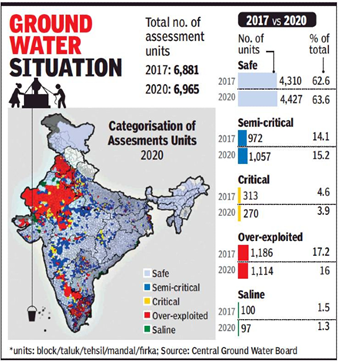Context:
- Data show that India, with nearly 18% of the world’s population, occupies about 2.4% of the total geographical area and consumes 4% of total water resources.
- A World Bank report says that India is the largest groundwater user and a rapidly growing economy and population are straining the country’s groundwater resources.
Importance of Groundwater:
- Groundwater is the water that seeps through rocks and soil and is stored below the ground. The rocks in which GW is stored are called aquifers.
- This hidden resource accounts for just 62% of the total water and 30% of the freshwater available on earth.
- The theme of UN World Water Day 2022 was ‘Groundwater, Making the Invisible Visible’ is a reflection of the importance given to the resource across the globe.
- Groundwater is the backbone of India’s agriculture and drinking water security in rural and urban areas, meeting nearly 80% of the country’s drinking water and two-thirds of its irrigation needs. Hence, Groundwater is pivotal to India’s water security.
Groundwater and its Availability in India:
- As a vast country, India has distinct and varying hydro-geological settings. For example,
- Hard-rock aquifers of peninsular India: These represent around 65% of India’s overall aquifer surface area, mostly found in central peninsular India.
- Alluvial aquifers of the Indo-Gangetic plains: Found in the Gangetic and Indus plains in Northern India, these have significant storage spaces.
- GW availability in India:
- Out of the 1,123 BCM (Billion Cubic Meter) /year usable water resources of the country, the share of GW is 433 BCM/year and setting aside 35 BCM for natural discharge, the net annual GW availability for the entire country is 398 BCM.

Groundwater Crisis in India:
- Given the interdependence of water, the environment and socioeconomic well-being, the challenges in Groundwater resource management are complex and multifaceted.
- These include -
- Unregulated extraction
- Excessive irrigation
- Poor knowledge of Groundwater management system
- GW pollution
- Climate change
- As per the 2021 CAG report, Groundwater extraction in India increased from 58% to 63%, between 2004-17, exceeding the Groundwater recharge rate and over extraction at the current rate can threaten nearly 80% of drinking water over next two decades.
- Climate change effects such as intermittent rainfall further alters the recharge potential, posing a huge threat to equitable, healthy and pollution-free access to Groundwater.
Steps Taken by the Central Government for Sustainable Groundwater Management:
- Collaborating with States and Union Territories: In this process, certain important deliverables have been identified that include -
- A reduction in groundwater extraction to below 70%,
- Increasing the network of groundwater observation wells,
- Installing digital water level recorders for real-time monitoring,
- Periodic monitoring of groundwater quality,
- Aquifer mapping and data dissemination,
- Having better regulation of groundwater extraction by industries, and
- Promoting participatory groundwater management and even periodic groundwater resource assessment.
- Creation of Jal Shakti Ministry in 2019: This is a much-needed policy reform that resulted in the merger of the former Ministries of Drinking Water and Sanitation with the Ministries of Water Resources, River Development, and Ganga Rejuvenation.
- Enabling community participation: The Jal Shakti Abhiyan was launched subsequently to transform Jan Shakti into Jal Shakti through asset creation, rainwater harvesting (‘Catch the Rain’ campaign) and extensive awareness campaign.
- Initiatives for the effective management and regulation of groundwater: Examples being the Atal Bhujal Yojana (ABY) and the National Project on Aquifer Management (NAQUIM).
- With the goal of “participatory groundwater management”, ABY looks to inculcate behavioural change made possible by incentivisation.
- NAQUIM envisages the mapping of sub-surface water bearing geological formations (aquifers) to help gather authentic data and enable informed decision-making.
- Region-wise aquifer management plans are being prepared and shared with States.
- Dynamic groundwater assessments: It will be done annually and a groundwater estimation committee formed to revise the assessment methodology. A software, ‘India-Groundwater Resource Estimation System (IN-GRES)’, has also been developed.
How did these Efforts Fare?
- The findings of the groundwater assessment 2022 indicate a positive inclination in the management of groundwater.
- For example, there has been
- A reduction in the number of ‘overexploited’ groundwater units and increase in the number of ‘safe’ category units as compared to 2017.
- An improvement in groundwater conditions in 909 units.
- A reduction in annual extraction (of about 9.53 BCM); the data for irrigation, industrial and domestic use, respectively, is 208.49 BCM, 3.64 BCM and 27.05 BCM.
- Overall extraction saw a declining trend, of about 3.25% since 2017.
- The government’s interventions reflect the spirit of cooperative federalism in managing GW.
Way Ahead:
- Communities will have to manage their groundwater resources better with the help of various government agencies and NGOs.
- In the context of climate change, as uncertainties will increase with connection with groundwater resources, efforts must be made to find solutions that are essential for sustainable development.
- It is important to ensure source sustainability to provide safe drinking water to all rural households by 2024, under the Jal Jeevan Mission.
Conclusion:
- As one of the fastest growing economies, India will need adequate groundwater resources to manage anthropogenic pressures.
- This is a new beginning and steps must be taken to make India a water surplus nation, thus fulfilling the objective of a key UN Sustainable Development Goal (6) - clean water and sanitation for all.









